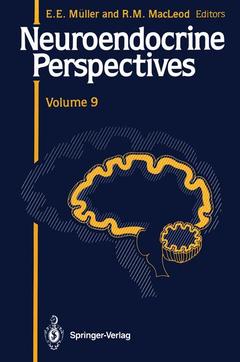Neuroendocrine Perspectives, Softcover reprint of the original 1st ed. 1991 Neuroendocrine Perspectives Series, Vol. 9
Langue : Anglais
Coordonnateurs : Müller Eugenio E., MacLeod Robert M.

This issue of Neuroendocrine Perspectives, Volume 9, begins with a fascinating aspect of neurobiology: the steroid control of vertebrate behavior, in this case aggressive behavior. In the first chapter, Schlinger and Callard, after an extensive historical perspective of the behavioral effects of steroid hormones, review results of their own and others' laboratories on the hormonal basis of individual and sex-related differences in the intensity ofaggressive displays in birds. These studies provide evidence that brain aromatase exerts considerable control over both sex-dependent and individual differences in aggressive behavior by controllingestrogenreceptoroccupancyinsteroid-sensitivebrainregions. A greatdeal ofattention has been devoted to psychological, socio economic and cultural factors as potential causes of drug abuse and dependence, whereas the information on the neurobiologic effects of drugs of abuse is rather scanty. Wand and Froehlich address this topic in an exhaustive chapter on the effects of ethanol on the release, synthesis and posttranslational processing of hypothalamo-hypophyseal hormones. In addition, in keeping with neurophysiological and epidemiological evidence of a genetic susceptibility to alcohol addiction, they present data to indicate how the neuroendocrine system may function as a marker for genetic susceptibility to ethanol addition.
Brain-Steroid Interactions and the Control of Aggressiveness in Birds.- Historical Perspective.- Aggression.- General Considerations.- Methods of Study.- Hormone Dependence of Aggressive Behavior.- Activational Effects.- Hormone Specificity.- Hormonal Basis of Behavioral Responsiveness.- Neuroanatomic Basis of Masculine Aggressiveness: Sites of Hormone Action.- Stimulation, Lesion and Steroid Implant Studies.- Steroid Target Cells in Brain.- Sexually Dimorphic Brain Structures.- Mechanisms of Hormone Action in the Central Nervous System.- Genomic Actions.- General Considerations.- Role of Nuclear Receptor.- Brain Steroid Receptors.- Steroid Metabolism in Neuroendocrine Tissues.- General Considerations.- Aromatization.- Reaction Properties.- Subcellular Distribution.- Neuroanatomic Distribution.- Role in Mediating Activational and Organizational Actions of Testosterone.- Regulation.- Control of Estrogen Receptor Occupancy.- 5?-Reduction.- 5?-Reduction.- Other Transformations.- Non-Genomic Actions.- Conclusions.- Alterations in Hypothalamo-Hypophyseal Functions by Ethanol.- Hypothalamic-Pituitary-Adrenal Axis.- Animal Studies.- Acute Ethanol Exposure.- Hypothalamus.- Anterior Pituitary.- Adrenal Gland.- Magnitude of HPA Axis Activation.- Summary.- Chronic Ethanol Exposure.- Hypothalamus.- Pituitary.- Tolerance.- Genetics and Tolerance.- Ethanol and Posttranslation Modification.- Interaction between Ethanol and Stress.- Summary.- Human Studies.- Nonalcoholics.- Alcoholics.- Summary.- Ethanol and the Enkephalinergic System.- Animal Studies.- Effect of Ethanol on Brain Enkephalin Content.- Ethanol Effects on Enkephalinergic Receptors.- Acute Ethanol Exposure.- Chronic Ethanol Exposure.- The Enkephalinergic System and Ethanol Consumption.- Human Studies.- Hypothalamic-Pituitary-Gonadal (HPG) Axis.- Male Rodent HPG Axis.- Ethanol Affects the Hypothalamus.- Ethanol Affects the Pituitary.- Male Monkey HPG Axis.- Male Human HPG Axis.- Acute Ethanol Challenge in Nonalcoholic Subjects.- Chronic Ethanol Exposure in Nonalcoholic Subjects.- Alcoholics.- Summary of Male HPG Axis.- Female Rodent HPG Axis.- Acute Ethanol Challenge.- Chronic Ethanol Exposure.- Female Monkey HPG Axis.- Acute Ethanol Challenge.- Chronic Ethanol Exposure.- Female Human HPG Axis.- Acute Ethanol Challenge.- Chronic Ethanol Exposure.- Summary of the Female HPG Axis.- Ethanol and Prolactin.- Animal Studies.- Human Studies.- Alcoholics.- Nonalcoholics.- Effect of Ethanol on Biological Activity and/or Clinical Function.- Ethanol and Growth Hormone.- Animal Studies.- Human Studies.- Nonalcoholics.- Alcoholics.- Ethanol and the Arginine Vasopressin System.- Animal Studies.- Acute Ethanol Exposure.- Chronic Ethanol Exposure.- AVP and Chronic Ethanol Tolerance.- AVP and Acute Ethanol Tolerance.- AVP and Genetic Differences in Acute Ethanol Tolerance.- Effect of AVP on Ethanol Addiction or Drinking Behavior.- Human Studies.- Alcoholics.- Nonalcoholics.- The Neuroendocrine Axis as a Marker of Genetic Risk for Alcoholism.- Prolactin as a Biological Marker of Alcoholism.- POMC-derived Hormones as a Biological Marker of Alcoholism.- Hypothalamic-Pituitary-Thyroid Axis.- Molecular Characterization and Distribution of Vascular Endothelial Growth Factor.- ntroduction.- dentification of VEGF from Folliculo-Stellate Cells.- urification of VEGF.- olecular Cloning of VEGF.- haracterization of VEGF.- xpression of VEGF.- ultured Cells.- issues.- ituitary Gland.- rain.- idney.- vary.- onclusions and Perspectives.- Neuroendocrinimmunology: Intersystem Communication by the Immune and Neuroendocrine Systems.- Overview of the Immune System.- T-Lymphocytes.- B-Lymphocytes.- Monocytes/Macrophages.- Natural Killer Cells.- Granulocytes and Mast Cells.- Lymphokines and Monokines.- Immune-derived Cytokine Effects in the Neuroendocrine System.- Interferon.- Interleukin 1.- Interleukin 2.- Thymus-derived Peptides.- Cytokines in the Neuroendocrine System.- Immunoregulatory Properties of Neuroendocrine Peptide Hormones.- Adrenocorticotropic Hormone.- Arginine Vasopressin.- Endogenous Opioids.- Growth Hormone.- ?-Melanocyte Stimulating Hormone.- Prolactin.- Other Neuropeptide Hormones.- Immunoregulatory Properties of Hypothalamic Releasing Hormones.- Neuropeptide Hormone Receptors Shared between the Immune and Neuroendocrine Systems.- Production, Regulation and Processing of Neuroendocrine Peptide Hormones by Cells of the Immune System.- Growth Hormone.- Thyrotropin.- Proopiomelanocortin-derived Peptides.- Future Applications of Neuroendocrinimmunology.- Prolactin Receptors in the Nervous and Immune Systems.- Prolactin and the Nervous System.- Prolactin Receptors in the Brain.- Distribution of Immunoreactive Prolactin in the Brain.- Distribution of Prolactin Binding Sites in the Brain.- Hypothalamus.- Median Eminence.- Choroid Plexus.- Modulation of Prolactin Receptors in the Brain in Aging.- Prolactin as an Immunomodulator.- Historical Perspective.- Structure of the Prolactin Receptor and Sequence Homology with Other Cytokine Receptors.- Demonstration of Prolactin Receptors in Immune Tissues.- Prolactin Receptor-mediated Functions in the Immune System.- Protein Kinase C as a Second Messenger for Prolactin Receptor-mediated Events.- Nuclear Prolactin Receptors, PKC and Immune Function.- Summary.
Date de parution : 09-2011
Ouvrage de 246 p.
15.2x22.9 cm
Disponible chez l'éditeur (délai d'approvisionnement : 15 jours).
Prix indicatif 105,49 €
Ajouter au panierThème de Neuroendocrine Perspectives :
Mots-clés :
attention; brain; nervous system; neurobiology; neuropeptides
© 2024 LAVOISIER S.A.S.



